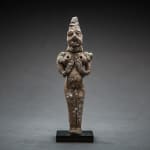Terracotta figurine of a fertility goddess, 2800 BCE - 2000 BCE
Terracotta
14 x 4.2 cm
5 1/2 x 1 5/8 in
5 1/2 x 1 5/8 in
LK.238
Further images
The Indus Valley Civilisation was a Bronze Age civilisation (3300–1300 BC) that mainly flourished in the northwestern regions of South Asia, extending from what today is northeast Afghanistan to Pakistan...
The Indus Valley Civilisation was a Bronze Age civilisation (3300–1300 BC) that mainly flourished in the northwestern regions of South Asia, extending from what today is northeast Afghanistan to Pakistan and northwest India.
Along with ancient Egypt and Mesopotamia it was one of three earliest civilisations of the world and of the three, the most widespread.
At its peak, the Indus Civilisation may have had a population of over five million.
Though the Indus Valley script remains undeciphered, the numerous seals, statuary and pottery discovered during excavations, not to mention the urban ruins, have enabled scholars to construct a reasonably plausible account of the Indus Valley civilization. Inhabitants of the ancient Indus river valley developed new techniques in handicraft (carnelian products, seal carving) and metallurgy (copper, bronze, lead, and tin). The Indus cities are noted for their urban planning, baked brick houses, elaborate drainage systems, water supply systems, and clusters of large non-residential buildings. After many decades of research, the Indus Civilization is still something of an enigma -- an ancient civilization with a writing system that still awaits convincing decipherment, monumental architecture whose function still eludes us, no monumental art, a puzzling decline, and little evidence of the identity of its direct descendants.
In a civilization extending over an area so vast, we expect to find monumental art and/or architectural symbols of power displaying the names of the powerful. Instead, we find an emphasis on small, elegant art and sophisticated craft technology. In this so-called "faceless civilization," three-dimensional representations of living beings in the Harappan world are confined to a few stone and bronze statues and some small objects crafted in faience, stone, and other materials - with one important exception. Ranging in size from slightly larger than a human thumb to almost 30 cm. in height, the anthropomorphic and animal terracotta figurines from Harappa and other Indus Civilization sites offer a rich reflection of some of the Harappan ideas about representing life in the Bronze Age.
Along with ancient Egypt and Mesopotamia it was one of three earliest civilisations of the world and of the three, the most widespread.
At its peak, the Indus Civilisation may have had a population of over five million.
Though the Indus Valley script remains undeciphered, the numerous seals, statuary and pottery discovered during excavations, not to mention the urban ruins, have enabled scholars to construct a reasonably plausible account of the Indus Valley civilization. Inhabitants of the ancient Indus river valley developed new techniques in handicraft (carnelian products, seal carving) and metallurgy (copper, bronze, lead, and tin). The Indus cities are noted for their urban planning, baked brick houses, elaborate drainage systems, water supply systems, and clusters of large non-residential buildings. After many decades of research, the Indus Civilization is still something of an enigma -- an ancient civilization with a writing system that still awaits convincing decipherment, monumental architecture whose function still eludes us, no monumental art, a puzzling decline, and little evidence of the identity of its direct descendants.
In a civilization extending over an area so vast, we expect to find monumental art and/or architectural symbols of power displaying the names of the powerful. Instead, we find an emphasis on small, elegant art and sophisticated craft technology. In this so-called "faceless civilization," three-dimensional representations of living beings in the Harappan world are confined to a few stone and bronze statues and some small objects crafted in faience, stone, and other materials - with one important exception. Ranging in size from slightly larger than a human thumb to almost 30 cm. in height, the anthropomorphic and animal terracotta figurines from Harappa and other Indus Civilization sites offer a rich reflection of some of the Harappan ideas about representing life in the Bronze Age.





